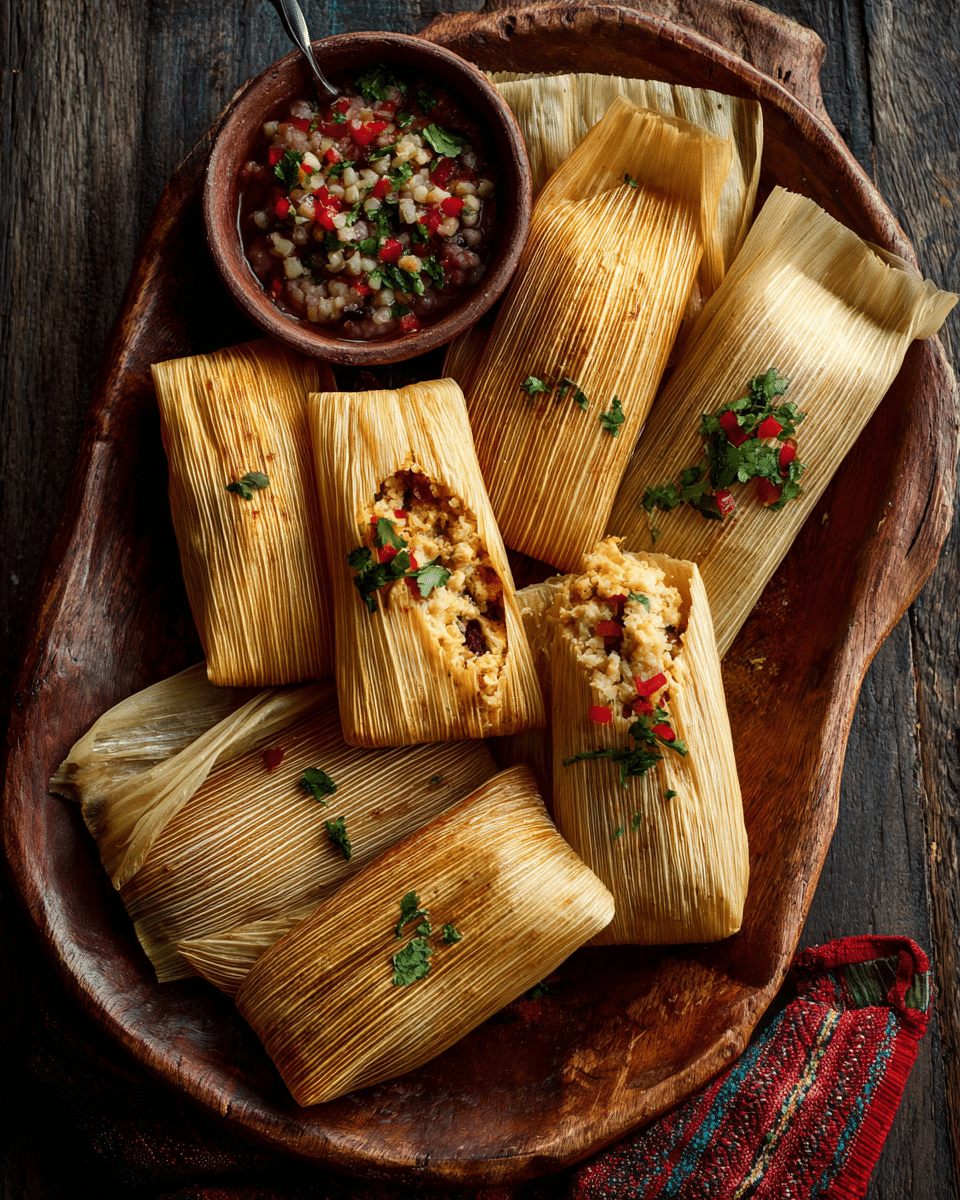Tamales are a traditional Mexican dish made of soft masa (corn dough) filled with savory or sweet fillings, wrapped in corn husks, and steamed to perfection. Often enjoyed during celebrations like Mexican Independence Day, tamales have deep cultural roots and a comforting, hearty flavor. Their versatility allows for endless variations, from pork in red chile sauce to chicken, cheese, or even sweet fruit fillings.
FULL RECIPE
Ingredients
- 3 cups masa harina (corn flour for tamales)
- 2 cups warm chicken or vegetable broth
- 1 cup lard or vegetable shortening
- 1 teaspoon baking powder
- 1 teaspoon salt
- 2 cups cooked shredded pork, chicken, or preferred filling
- 1 cup red chile sauce or salsa verde (for savory tamales)
- 20–25 dried corn husks, soaked in warm water until pliable
- Additional broth as needed for spreading consistency
Directions
- Soak the dried corn husks in warm water for at least 30 minutes, until soft and pliable. Drain and set aside.
- In a large mixing bowl, beat the lard or shortening with an electric mixer until light and fluffy, about 3–5 minutes.
- In another bowl, mix masa harina, baking powder, and salt. Gradually add the warm broth, stirring until combined.
- Add the whipped lard into the masa mixture and beat until smooth, fluffy, and spreadable. Add more broth if necessary.
- Mix the shredded meat with the chile sauce or salsa verde until well coated.
- Lay a softened corn husk flat, smooth side up. Spread 2–3 tablespoons of masa dough in the center, leaving about 1–2 inches at the top and bottom free of dough.
- Add 1–2 tablespoons of the filling in the center of the masa.
- Fold the sides of the husk over the filling, then fold up the bottom flap to seal. Leave the top open.
- Arrange tamales upright in a steamer basket. Add water to the bottom of the steamer without touching the tamales.
- Cover with additional corn husks or a damp kitchen towel, then place the lid on the steamer.
- Steam over medium heat for 1.5–2 hours, checking occasionally and adding more water as needed.
- Tamales are done when the masa pulls away easily from the husk. Let them rest for 10 minutes before serving.
Nutrition Facts
- Calories: 210
- Protein: 8g
- Fat: 12g
- Saturated Fat: 5g
- Cholesterol: 25mg
- Carbohydrates: 18g
- Fiber: 3g
- Sugars: 1g
- Sodium: 290mg
Cultural Significance of Tamales
Tamales hold a deep-rooted cultural value in Mexican heritage, particularly during celebrations like Mexican Independence Day, Christmas, and family gatherings. They are more than just food; they are a symbol of unity, tradition, and shared labor. The process of making tamales often involves multiple family members coming together, from soaking the corn husks to spreading the masa and folding the bundles. This communal preparation fosters a sense of togetherness and helps pass down traditional cooking techniques from one generation to the next. The act of unwrapping a tamal at the table adds a celebratory feel, as if each serving is a small, delicious gift.
Nutritional Profile and Health Considerations
Tamales can be a hearty and balanced meal, depending on the ingredients used. Masa, made from nixtamalized corn, provides fiber, essential minerals, and complex carbohydrates for sustained energy. The protein content comes from the filling—commonly pork, chicken, or beans—which supports muscle repair and satiety. However, traditional recipes often include lard for richness, which increases saturated fat content. Health-conscious cooks may opt for vegetable shortening or a smaller amount of oil to reduce calories and fat. Adding vegetables or legumes to the filling can boost the nutrient density, making tamales a more wholesome choice.
Popular Savory Fillings
The beauty of tamales lies in their adaptability to various flavors. Common savory fillings include shredded pork with red chile sauce, chicken with salsa verde, or cheese with roasted poblano peppers. Regional specialties in Mexico also offer unique tastes, such as mole tamales from Oaxaca or tamales with black beans from Chiapas. The seasoning of the filling is essential, as the steaming process infuses the masa with its aroma and flavor. Home cooks can experiment with different meats, sauces, and seasonings to create their preferred tamal style, adapting spice levels to suit personal tastes.
Sweet Tamale Variations
In addition to savory versions, sweet tamales are a beloved treat across Mexico. They may be filled with ingredients like sweetened masa, raisins, pineapple, cinnamon, or even chocolate. The masa itself can be tinted with natural colors, such as pink for strawberry-flavored tamales or green for pandan-infused varieties. Sweet tamales are often served as a dessert or breakfast item, paired with a warm beverage like atole or champurrado. Their softer, sweeter profile makes them especially appealing to children and those looking for a lighter, festive option.
Pairing Tamales with Side Dishes
Tamales are satisfying on their own but become even more delightful when served with complementary sides. Popular accompaniments include Mexican rice, refried beans, or a simple salad to add freshness. Salsas, both red and green, enhance flavor and moisture. For a festive spread, tamales can be paired with elote (Mexican street corn), guacamole, or a tangy pickled vegetable mix called escabeche. A variety of sides not only balance the flavors but also offer guests a complete dining experience that captures the richness of Mexican cuisine.
Beverage Pairings for Tamales
The right beverage can elevate the tamale-eating experience. For savory tamales, cold drinks like agua fresca (hibiscus, tamarind, or horchata) provide a refreshing contrast to the warm, hearty flavors. In cooler weather, hot beverages like atole or Mexican hot chocolate complement the soft masa and spicy fillings perfectly. For adult gatherings, pairing tamales with beer, tequila, or mezcal can add a celebratory touch. These pairings allow diners to experience a harmonious balance between food and drink, making the meal more memorable.
Tips for Perfect Masa Texture
The success of a tamal often depends on the quality and texture of the masa. It should be light, fluffy, and well-seasoned before spreading on the corn husks. Whipping the fat before combining it with the masa harina ensures a tender, airy texture. Adding broth gradually and testing the masa’s spreadability is key—too dry and it will crack, too wet and it will be difficult to handle. A simple test is to drop a small ball of prepared masa into water; if it floats, it’s ready. This careful attention to masa preparation can significantly enhance the final product.
Storage and Reheating Advice
Tamales store well and can be enjoyed days after preparation. Once cooled, they can be kept in the refrigerator for up to a week or frozen for several months. For best results, store them in their husks to retain moisture. Reheating can be done by steaming to restore their original texture, or by microwaving with a damp paper towel to prevent drying. Frozen tamales should be thawed in the refrigerator before reheating. These storage tips make tamales a convenient make-ahead option for busy weeks or holiday feasts.
Making Tamales in Large Batches
Because tamale preparation is time-intensive, many families choose to make them in large quantities. This approach is efficient and allows for a variety of fillings to be prepared in one session. Large-batch cooking also makes tamales an ideal option for celebrations and gatherings, where dozens or even hundreds can be steamed and served. They can be portioned out for guests to take home, adding to the sense of generosity and hospitality that tamales symbolize. The process also becomes an event in itself, where cooking and conversation go hand in hand.
Regional Differences Across Mexico
Tamales vary greatly from one Mexican region to another, reflecting the diversity of the country’s culinary heritage. In northern Mexico, tamales are often larger and wrapped in parchment paper, while in the south, banana leaves are sometimes used instead of corn husks, giving a distinct flavor and aroma. Central Mexico tends to favor traditional corn husk wrapping with a variety of fillings and sauces. These regional adaptations demonstrate the adaptability of the tamal and its ability to incorporate local ingredients and techniques, keeping the tradition alive in many forms.
Conclusion
Tamales are more than just a beloved dish they are a culinary tradition that bridges the gap between food and culture. Their versatility in fillings, from savory meats to sweet fruits, ensures there is a tamal for every palate. Beyond taste, the process of making tamales fosters connection, creativity, and celebration, making them an essential part of Mexican heritage.






